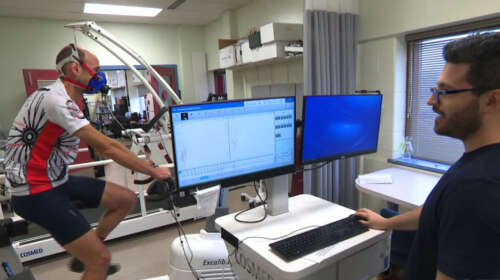A man living with Parkinson’s disease who completed an 85-day cross-country cycling trip saw significant reduction in his disease symptoms, say University of Guelph researchers who assessed the man’s condition for new research.

Their findings appear in the journal Physiological Reports and offer important insight into the role intense aerobic exercise can play in relieving symptoms of Parkinson’s disease, also known as PD.
Steve Iseman, 57, was diagnosed eight years ago with PD and has worked to stay active since physical exercise has long been recommended to help reduce PD symptoms of tremors, stiffness and difficulty with balance.
But it’s never been clear how much exercise is enough to see benefits, nor whether there is a limit to the benefits of exercise on PD symptoms.
Cycling trip turned research study
To understand these questions better, researchers in U of G’s Human Health and Nutritional Sciences (HHNS) teamed up with Iseman as he embarked on a nearly 8,000-kilometre cycling trip across Canada dubbed Spinning Wheels, riding for an average of 100 kilometres a day.

Lead researcher Dr. Philip Millar, an HHNS professor who researches cardiovascular physiology, said following Iseman’s journey was “a unique opportunity to see someone do an exercise regime that is far-and-above what would be prescribed or what the average person would do.”
Millar’s team assessed Iseman’s PD symptoms before and after the trip using a standard Parkinson’s evaluation scale, as well as his muscle strength, balance, gait and cardiovascular responses to exercise.
They found a dramatic improvement in his motor symptoms. Iseman’s ratings on the Unified Parkinson Disease Rating Scale (UPDRS) Part III motor score decreased 44 per cent, from a score of 46 to 26.
Iseman’s ability to generate power through knee extensions increased 12 per cent over the trip, and his score on a standard test to measure Parkinson’s fatigue, the PFS‐16, decreased 32 per cent, from a score of 3.4 to 2.3.
“Iseman displayed a huge drop,” Millar says. “There is no study that shows such capacity.”
Exercise had ‘powerful’ impact on Parkinson’s symptoms

No major changes were observed in Iseman’s gait or static balance. But many of his other symptoms improved so much during the trip that Iseman periodically skipped his evening dose of PD medications.
Millar describes the changes in Iseman’s abilities as “profound.” While he cautions this is a single case study, it nevertheless offers insight as to how much exercise can help alleviate symptoms of Parkinson’s disease.
“It’s anecdotal, but it’s quite powerful to see the benefit of exercise,” he says. “Typically, returns start to decrease at a certain amount of time or intensity, but in Iseman’s case, there were profound improvements in motor symptoms in a person already doing high levels of exercise.”
He added that the extent to which Iseman’s symptoms improved on his cross-Canada ride offers promising avenues of research.
“Iseman’s experience offers a motivating, forward-looking view of the improvements someone who’s newly diagnosed could experience.”
Millar’s findings were recently featured on CTV News.
Contact:
Dr. Phillip Millar
pmillar@uoguelph.ca
